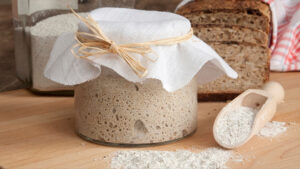Sourdough
Bread always and forever
Bread, the foundation of our diet, a companion throughout the history of civilization development, a driver of agricultural progress… once and now it remains a symbol of nutrition, energy and life. According to historical traces, the skill of making bread by adding yeast developed in ancient Egypt and ancient Rome, and this method of preparation significantly changed the taste, structure, appearance and nutritional quality of bread. The symbolism and importance of bread in today’s diet is still strong although somewhat shaken. We live in an era of industrial bread and bakery product production whose availability is increasing, leading us to increased consumption of bread of poorer nutritional quality, containing numerous additives, hydrogenated vegetable fats and high amounts of salt. Fortunately, on the other hand, today there is an increasing trend of returning to bread production from exclusively natural ingredients, without additives, with the addition of sourdough and ingredients that are sources of dietary fiber, omega fatty acids, vitamins and minerals.
What is sourdough?
Sourdough is a natural starter, a mixture of flour and water in which spontaneous fermentation of bacteria and yeasts naturally present in the flour occurs under favorable temperature conditions. The microflora of sourdough consists predominantly of lactic acid bacteria and yeasts in an active state. During fermentation, lactic acid bacteria produce lactic and acetic acid as well as other metabolites, giving bread its special sour taste and aroma. While lactic acid fermentation bacteria are responsible for the dough acidification process, the present yeasts are crucial for dough rising. Sourdoughs can be created through natural fermentation, however, today so-called defined sourdoughs are often made by adding precisely determined starter cultures. Sourdough therefore ensures better bread properties, from fullness of flavor to freshness and durability. Together with classic yeast added in bread preparation, an ideal tandem is created of so-called wild yeast varieties and bacteria from sourdough and classic baker’s yeast; Saccharomyces cerevisiae.

Nutritionally rich and tastier bread
Naturally present microorganisms through their synergistic action in the process of fermentation and starch breakdown from flour create the necessary amount of carbon dioxide that contributes to greater volume and the recognizable porous structure of baked bread. During fermentation, organic acids and numerous amino acids are also formed, contributing to the nutritional quality and aroma of freshly prepared bread. Another important characteristic of bread prepared with sourdough addition is its easier and better digestibility, as well as improved bioavailability of nutrients, from B vitamins to minerals such as copper, zinc, magnesium and others. Additionally, as a byproduct of lactic acid fermentation, various oligosaccharides such as glucans and fructans are formed, which act as prebiotics and favorably affect intestinal microbiota and thus digestive health. From a health perspective, sourdough bread also contributes to more favorable blood glucose level regulation, as natural yeasts affect the structure of starch molecules, thereby reducing the bread’s glycemic index. Finally, the nutritional quality and durability of bread with sourdough addition is greater precisely because of its specific composition that contributes to longer maintenance of freshness, softness and durability.

